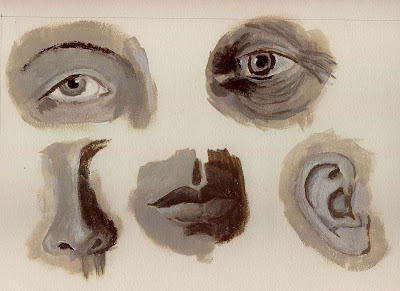 I really like Andre Derain's bathers. Looking through all of the Derains I could find, this painting intrigued me. His version is a bit more purple (which I couldn't seem to match) all over which makes it somewhat weird. I put a slight purple glaze over it, but really didn't dare mess with it too much. Actually, the scanner has darkened it up so that it looks more like a night scene. Before scanning it is definitely more dayish. I like the rhythm of the earth and boulders, and the shapes of the tree trunks and branches. I thought this would be easy after Monet and Van Gogh, but it wasn't. I found it difficult to get the right shades. He has an under painting in a pinkish hue, that is quite light in the lower part of the painting, but fairly strong beneath a grey purple sky. Getting the grey purple was difficult, as I didn't have any black or grey. I had to lighten the mixture with white, which one should avoid because it is opaque and you lose the transparency of the glaze, which I wanted to retain.
I really like Andre Derain's bathers. Looking through all of the Derains I could find, this painting intrigued me. His version is a bit more purple (which I couldn't seem to match) all over which makes it somewhat weird. I put a slight purple glaze over it, but really didn't dare mess with it too much. Actually, the scanner has darkened it up so that it looks more like a night scene. Before scanning it is definitely more dayish. I like the rhythm of the earth and boulders, and the shapes of the tree trunks and branches. I thought this would be easy after Monet and Van Gogh, but it wasn't. I found it difficult to get the right shades. He has an under painting in a pinkish hue, that is quite light in the lower part of the painting, but fairly strong beneath a grey purple sky. Getting the grey purple was difficult, as I didn't have any black or grey. I had to lighten the mixture with white, which one should avoid because it is opaque and you lose the transparency of the glaze, which I wanted to retain.Technique wise, you will see some fairly smooth blending of colors and shading on the mounds and some of the tree trunks. I appear to have forgotton the main one. This is a vast improvement over my initial attempts to blend with acrylic. Medium helps, and I use a second brush damp with water to brush out the transition. I also use thin glazes, so I build up the color slowly. I hope this will enable better portraits.


























